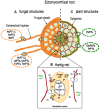From soil to plant, the journey of P through trophic relationships and ectomycorrhizal association
- PMID: 25360140
- PMCID: PMC4197793
- DOI: 10.3389/fpls.2014.00548
From soil to plant, the journey of P through trophic relationships and ectomycorrhizal association
Abstract
Phosphorus (P) is essential for plant growth and productivity. It is one of the most limiting macronutrients in soil because it is mainly present as unavailable, bound P whereas plants can only use unbound, inorganic phosphate (Pi), which is found in very low concentrations in soil solution. Some ectomycorrhizal fungi are able to release organic compounds (organic anions or phosphatases) to mobilize unavailable P. Recent studies suggest that bacteria play a major role in the mineralization of nutrients such as P through trophic relationships as they can produce specific phosphatases such as phytases to degrade phytate, the main form of soil organic P. Bacteria are also more effective than other microorganisms or plants at immobilizing free Pi. Therefore, bacterial grazing by grazers, such as nematodes, could release Pi locked in bacterial biomass. Free Pi may be taken up by ectomycorrhizal fungus by specific phosphate transporters and transferred to the plant by mechanisms that have not yet been identified. This mini-review aims to follow the phosphate pathway to understand the ecological and molecular mechanisms responsible for transfer of phosphate from the soil to the plant, to improve plant P nutrition.
Keywords: bacterial grazers; ectomycorrhizal association; phosphate; phosphate transport systems; tree P nutrition.
Figures


References
-
- Anderson R. V., Coleman D. C., Cole C. V., Elliott E. T. (1978). Effect of the nematodes Acrobeloides sp. and Mesodiplogaster lheritieri on substrate utilization and nitrogen and phosphorus mineralization in soil. Ecology 62 549–555 10.2307/1937720 - DOI
-
- Antibus R. K., Sinsabaugh R. L., Linkins A. E. (1992). Phosphatase activities and phosphorus uptake from inositol phosphate by ectomycorrhizal fungi. Can. J. Bot. 70 794–801 10.1139/b92-101 - DOI
-
- Ashford A. E., Allaway W. G. (2002). The role of the motile tubular system in mycorrhizal fungi. Plant Soil 244 177–187 10.1023/A:1020271121683 - DOI
Publication types
LinkOut - more resources
Full Text Sources
Other Literature Sources
Research Materials
Miscellaneous

